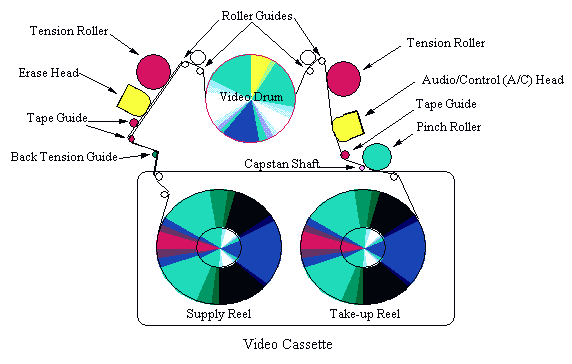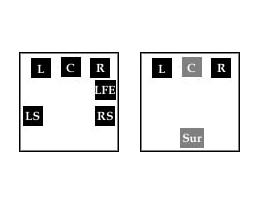Revised 3-24-2024
The first time I can remember noticing that video tape recorders even existed was during a Sunday football game in the early 1970s. The announcer said that they had a new gadget they wanted to demonstrate, and proceeded to show an instant replay by video tape. I purchased my first VCR (Video Cassette Recorder) in 1981. It had three speeds, monophonic sound, and a set of tuners which had to be manually set to the desired stations by turning a small thumbwheel for each tuner. It had a remote control, but I never used it because the controls were also on the front panel of the VCR in very large sized buttons (about 8 buttons). The unit cost more than $1,000 and lasted about 10 years before I had to replace it. Now, VCRs can be purchased for about $500, with high fidelity stereo sound even at the slow speed, numerous features, so numerous in fact, that the remote control is absolutely necessary.

VCRs work somewhat differently than an analog audio cassette deck used for recording music. The recording head in a VCR (and video cameras) is cylindrical, and tilted at an angle. It spins while the tape moves past it, giving a higher effective recording speed (amount of tape moving past the head per second). The signal is thus recorded at an angle on the tape. The video signal plus stereo sound (with Hi-Fi VCRs) is recorded at this angle. Audio with this type of recording head is very good, even at slow recording speeds. On better machines, the erase head is also on the spinning cylindrical head, sometimes called a flying erase head. This produces sharp breaks when stopping and starting recordings in the middle of the tape. If your VCR does not have this feature, then the beginning of a recording has streaks of color that move up and down for a few seconds. So, flying erase heads are very nice, particularly if you are editing home videos, but also just for recording in general. The problem with the spinning head, present in all VCRs, is that it is very delicate, easily scratched if you are not careful when cleaning the VCR, and is one more moving part in a component filled with such parts. This results in the VCR being the most often repaired component in home electronics.
heads are very nice, particularly if you are editing home videos, but also just for recording in general. The problem with the spinning head, present in all VCRs, is that it is very delicate, easily scratched if you are not careful when cleaning the VCR, and is one more moving part in a component filled with such parts. This results in the VCR being the most often repaired component in home electronics.
All analog video, such as older TVs and VCRs, were subject to a problem called “dot crawl”. This showed up along horizontal or diagonal edges of objects that have contrasting colors (for example, yellow adjacent to blue), and looks like a moving stairway (escalator). It was caused by the imperfect ability of the comb filter in the TV (or video player) to separate the color signal from the luminance (brightness) because the frequencies overlap. The overlap resulted in intermodulation. The amount of dot crawl varied with the quality of the TV, but also those units with special image processing features that allowed you to enlarge the picture to fill the screen or to magnify a part of the image you wanted to see in more detail.
If you visited a home electronics store back in the day, you were faced with an entire wall of VCRs to choose from. Most of them were VHS format, with a small number of Super-VHS, Hi-8, and maybe even a digital camcorder. They are considered “vintage” products now and are pretty much just for collectors. Their resolution is very poor compared to modern digital TVs.


